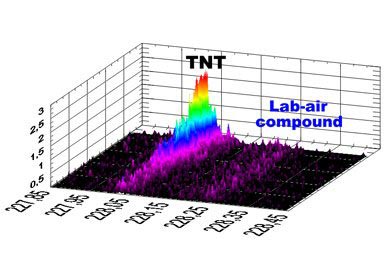
Transport authorities are about to be presented with a new type of body scanner that could identify explosives on the clothes of passengers with unprecedented resolution and fewer false alarms. The device has been created by academics and their spin-off company based in Austria by adapting a mass spectrometry technique that is common in environmental science.
Foiled terrorist attacks in New York City and Detroit in the past year have raised security levels, which were already on high alert since the attacks on New York in 2001. In response, governments around the world have been seeking more advanced technologies to scan travellers for weapons and explosives in airports. Any new technology deployed, however, must always represent a difficult balance between many factors including quality, cost and intrusiveness. Indeed, some passengers and human rights groups have already protested that full-body scanning is in breach of an individual’s rights. And various scientists have said that existing scanners are not fit for purpose anyway because there are common explosives that could pass through the scan undetected.
Spectrometry, a ubiquitous chemistry technique for determining the quantity or concentration of chemical species, offers a more directed approach to detecting chemical traces. One variety known as ion mobility spectrometry (IMS) is already used in a number of airport scanning systems. It works by taking a sample of dust from each passenger – usually by wiping their shoe with a cloth – and transferring this sample to an ionization chamber. The problem with IMS is that it is prone to false alarms because it is sensitive to interference and cannot distinguish between different types of volatile.
Quick puff of air
Now, however, a research group based at the University of Innsbruck claims to have created a new type of scan, based on an alternative mass spectrometry technique, which is far more sensitive and reliable. It involves a process known as proton-transfer-reaction mass spectrometry (PTR-MS) and the scanning process begins by blasting each passenger with a quick puff of air, which should liberate any residual explosives. This passenger “dust” is then passed into a chamber containing protonated water, which contains water molecules with an extra proton. If the passenger were to have traces of explosives about their person, the extra protons would “jump” to these volatile compounds because they have a higher proton affinity. Finally, the water vapour mix is passed into a high-resolution mass spectrometry device, which can identify protonated explosives in less than a second.
Since inventing the technique, academics at the University of Innsbruck have created a spin-off company, Ionicon Analytic, which has gone on to fine-tune the technology. It now works to a sensitivity of one part per quadrillion (1015), with the scanner being comparable to a standard home refrigerator in size. Kurt Becker, who works for Ionicon but is based at the Polytechnic University of New York, says that his project is seeking contracts with security agencies in the UK, Germany and France. He also revealed that he intends to meet with operators of New York airports to present the technology within the next few weeks.
Negotiations should be aided by the fact that this spectrometry technique is already established in a number of other applications including waste incineration and air quality control. Becker says that his company was inspired to adapt the technique for airport security after recent security alerts, which led to fears that terrorists are getting smarter with their methods and the type of substances they might deploy. “Terrorists may use improvized devices involving a combination of different explosives, including TNT, RDX, HDX and PETN,” he tells physicsworld.com.
Selectivity issues
Paul Monks, a chemist at the University of Leicester in the UK, agrees that the technique does hold benefits over established scanners. “Though ion mobility spectrometry is sensitive, it does suffer from selectivity issues,” he says. “The advantages of PTR-MS and its variants is that only those molecules with proton affinities in excess of that of H2O can accept a proton from H3O+, a criterion that excludes the major components of air such as N2, O2 and CO2, but includes many trace gases, including most volatile organic compounds.”
Ionicon and its various academic partners intend to develop the technology by improving the user interface to make life easier for security guards. “To make this airport-ready we need to create a push-button system,” says Chris Mayhew, one of Ionicon’s affiliates based at the University of Birmingham in the UK. Mayhew says that he will be presenting the technology to the UK government at a meeting in London this week.



